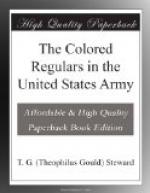Excepting the Louisiana Native Guards, the First South Carolina Volunteers was the first regiment of colored troops to be mustered into the service in the Civil War. The regiment was made up entirely of slaves, with scarcely a mulatto among them. The first day of freedom for these men was passed in uniform and with a gun. Among these Negroes, just wrested from slavery, their scholarly commander, Colonel Higginson, could find many whom he judged well fitted by nature to command.
“Afterwards I had excellent battalion drills,” he writes, “without a single white officer, by way of experiment, putting each company under a sergeant, and going through the most difficult movements, such as division columns and oblique squares. And as to actual discipline, it is doing no injustice to the line-officers of the regiment to say that none of them received from the men more implicit obedience than Color-Sergeant Rivers. * * * It always seemed to me an insult to those brave men to have novices put over their heads, on the ground of color alone, and the men felt it the more keenly as they remained longer in the service. There were more than seven hundred enlisted men in the regiment, when mustered out after more than three years’ service. The ranks had been kept full by enlistment, but there were only fourteen line-officers instead of the full thirty. The men who should have filled these vacancies were doing duty as sergeants in the ranks."[29]
Numerous expeditions were constantly on foot in the Department of the South, having for their object the liberation of slaves still held to service in neighborhoods remote from the Union camps, or to capture supplies and munitions of war. Frequently these expeditions came in conflict with armed bodies of rebels and hot engagements would ensue, resulting in considerable loss of life. Colored soldiers were particularly serviceable for this work because of their intimate knowledge of the country and their zeal for the rescue of their enslaved brethren.




